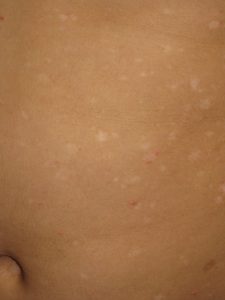Chapter 4: Papulosquamous Disorders
Pityriasis Lichenoides (PLC/PLEVA)
What is it?
Pityriasis lichenoides is an inflammatory skin reaction that can be seen in either chronic (Pityriasis lichenoides chronica/PLC) or acute (Pityriasis lichenoides et varioliform acuta/PLEVA) forms. It is seen most commonly in teens and young adults but can occur in younger children. The cause is unknown, but cases are known to occur after viral infections.

What does it look like?
PLC presents with small erythematous papules with slight scale scattered widely over the body. The trunk is most commonly affected, and the papules often resolve leaving post-inflammatory hypo- or hyper- pigmentation. Lesions in different stages are often visible. Symptoms are usually minimal. PLEVA presents with larger inflammatory papules which also have central scale, but may have pus or blood within the center. The lesions are painful, can ulcerate, and may be associated with the presence of systemic symptoms.
How is it treated?
Topical steroids can be utilized to minimize symptoms, but do not generally clear the problem. When available, phototherapy is first line treatment. If not available, ambient sun with care to avoid sunburn is an option. Oral antibiotics such as erythromycin or tetracyclines can be trialed. Patients should be monitored with regular follow-up due to the rare occurrence of transformation to cutaneous T cell lymphoma. Acitretin, methotrexate, cyclosporine, griseofulvin and metronidazole have been trialed in small studies.

